A Trip To Binondo : Seng Guan Temple
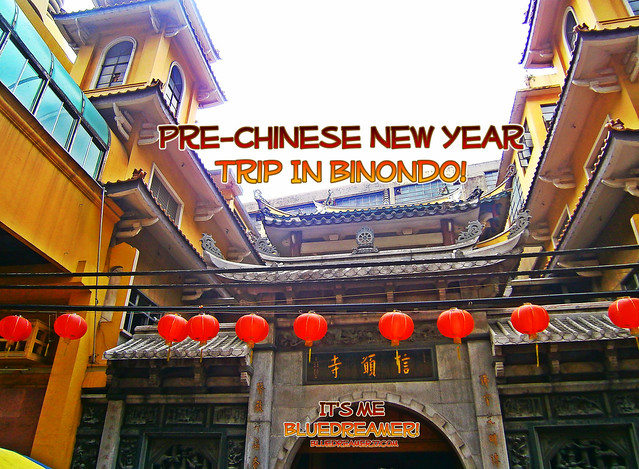
After that stomach-fulfilling breakfast at Cafe Mezzanine, our next stop is a well known Chinese temple in Manila. The original plan is to take a calesa ride from Binondo Church to Narra St but since my auntie called and joined us with our trip, we had to take a bigger ride. I contracted a Tricycle driver to take us there. Unlike the typical tricycle, the ones in Binondo are quite big and spacious. He asked Php100 for the ride but my Aunt told me that it’s too much for a short ride. I realized that you can actually walk from Binondo to Narra St since it is not that far. 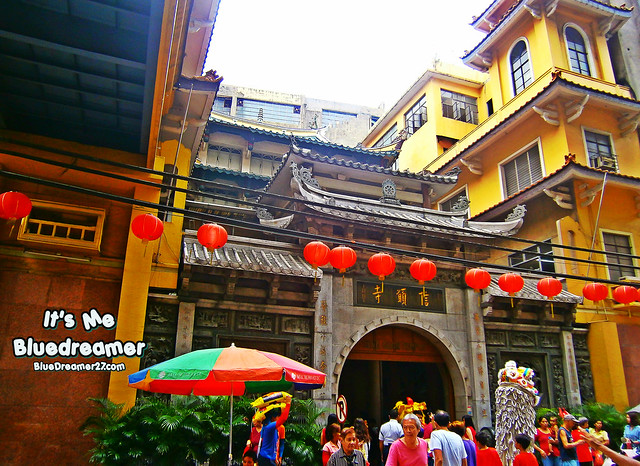

UPDATED PHOTO
We were welcomed by an overwhelming crowd in front of the temple and there was a lion dance performance too. Seng Guan Temple is one of the well known Chinese temples in Manila and is considered as a major cultural center for the Chinese Filipino community.The temple was named after Venerable Seng Guan (1889-1962), a monk from Fu Kien (Fujian), China, who was active in teaching and organizing work in Southern China, Manila, and Rizal. His work laid the foundations for several institutions, including the Samantabhadra Institute in Santa Cruz, Manila, and the Hwa Chong Buddhist Temple complex in Tugatog, Malabon, Rizal (now Malabon, Metro Manila), where his ashes are enshrined in a stupa. The Seng Guan Temple is considered as one of the most beautiful Buddhist temples in the Philippines. It has a beautiful facade with a huge Stupa on top which can easily be noticed from a far. The exterior might look small but it’s surprisingly very spacious inside. I also noticed that the temple is connected to the building in front of it.
The Seng Guan Temple is considered as one of the most beautiful Buddhist temples in the Philippines. It has a beautiful facade with a huge Stupa on top which can easily be noticed from a far. The exterior might look small but it’s surprisingly very spacious inside. I also noticed that the temple is connected to the building in front of it.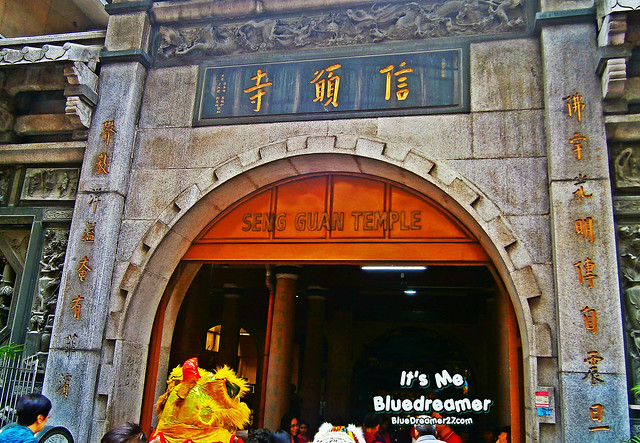 The temple’s main entrance adorned with Chinese markings and impressive intricate carvings.
The temple’s main entrance adorned with Chinese markings and impressive intricate carvings.

UPDATED PHOTO
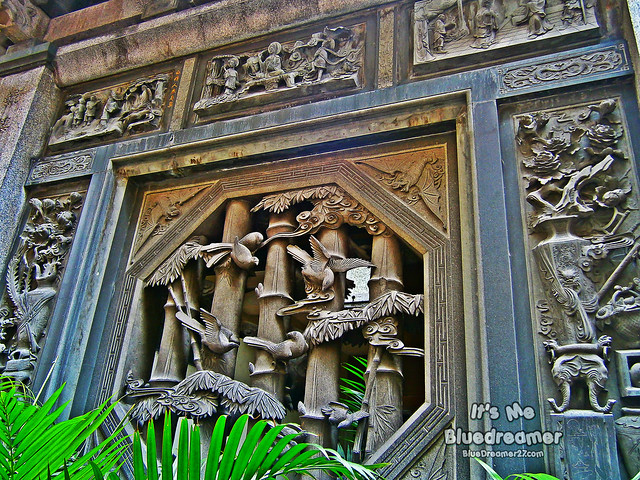 Check out these intricate carvings outside the temple.
Check out these intricate carvings outside the temple. 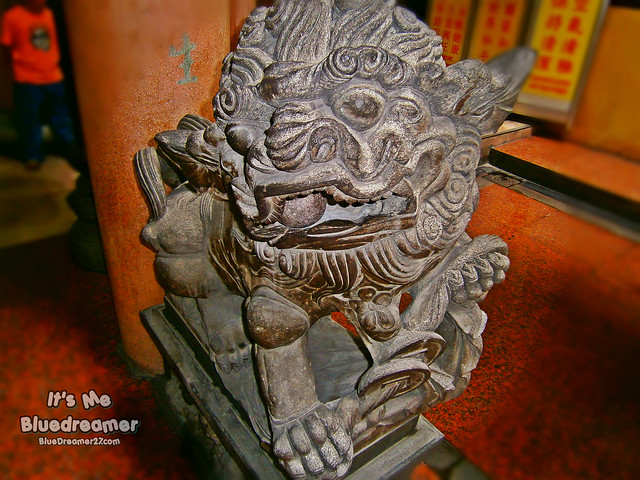 As you enter the building, you will be welcomed by two of these stone lions
As you enter the building, you will be welcomed by two of these stone lions 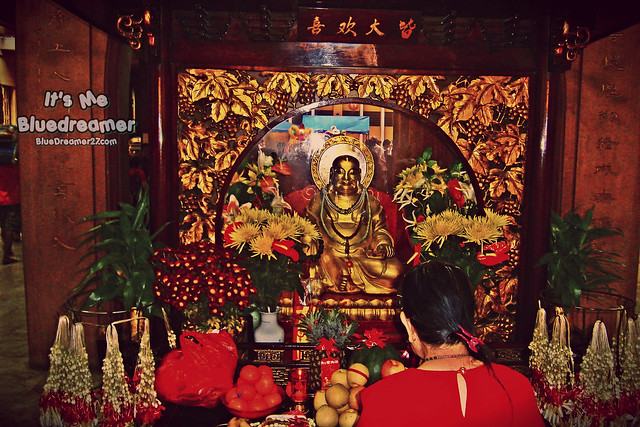 and also this golden Buddha on the center. People offers fruits, flowers, incense and more and place it in front of the shrine.
and also this golden Buddha on the center. People offers fruits, flowers, incense and more and place it in front of the shrine.
•Point of clarification, not all images in the Temple are called Buddha, they are called deities or bodhisattva, similar to Catholic saints. They are there for specific reasons one is for protection, wealth etc.
 Here’s another image of a deity on the other side!
Here’s another image of a deity on the other side!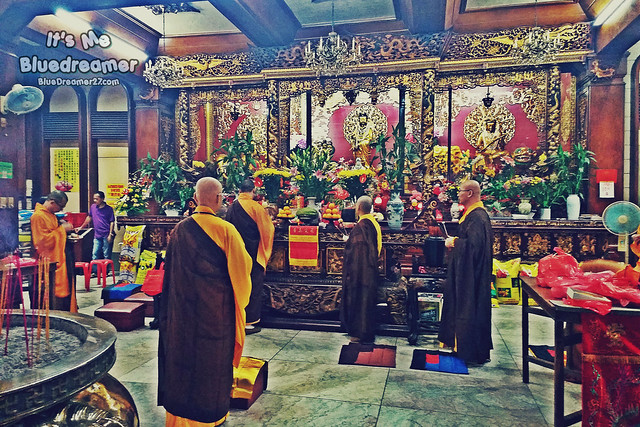 Again, you we are greeted by a huge crowd (mostly Chinese) and we are lucky enough to witness a ritual done by a group of Monks (I have read an article that these are monks from Taiwan)
Again, you we are greeted by a huge crowd (mostly Chinese) and we are lucky enough to witness a ritual done by a group of Monks (I have read an article that these are monks from Taiwan)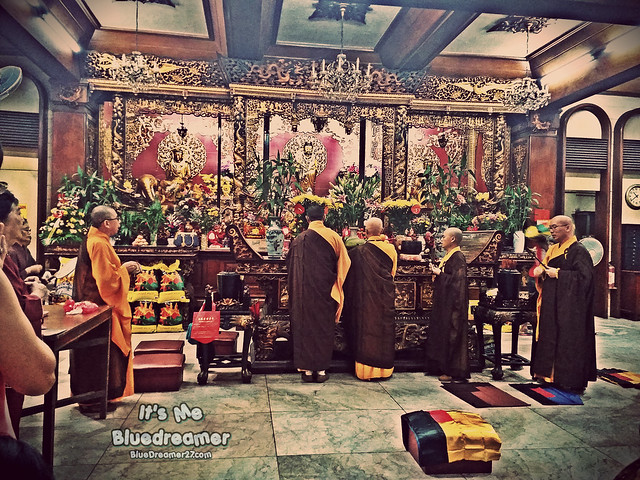 I’m not sure how they called it but this shrine or altar has three golden image of their deities on it. I was really impressed with the details.
I’m not sure how they called it but this shrine or altar has three golden image of their deities on it. I was really impressed with the details.
 I came across an article on how to pray in a Buddhist temples telling me that you should grab three pieces of incense sticks, light them up and state your prayer or wishes in front of the Buddhas. I’m not sure if that’s really the right way but I have done it anyway ^_^
I came across an article on how to pray in a Buddhist temples telling me that you should grab three pieces of incense sticks, light them up and state your prayer or wishes in front of the Buddhas. I’m not sure if that’s really the right way but I have done it anyway ^_^
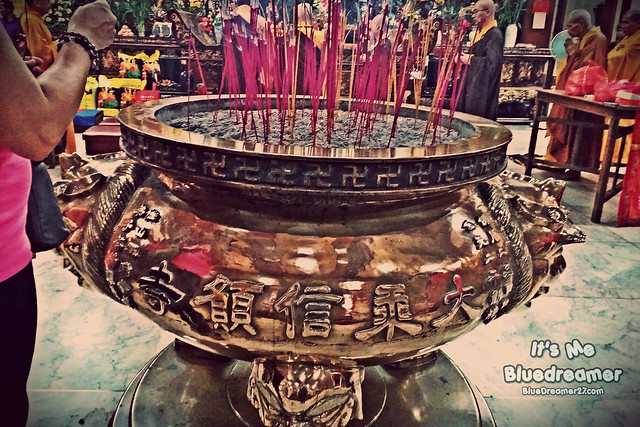 A huge bowl of ashes where you can place the incense sticks.
A huge bowl of ashes where you can place the incense sticks.

UPDATED PHOTO
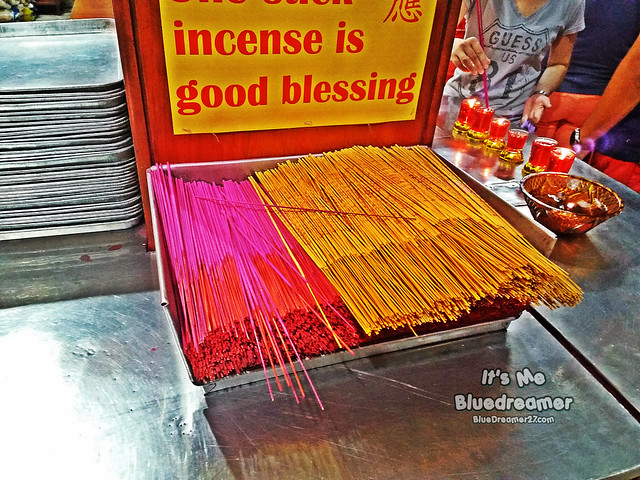 For the incense, yellow is used if a love one dies bellow 3 years and red ones if they have been gone for more than 3 years. That is if you are praying for their soul. If for personal reasons use red or you have to count all the deities in the temple and leave 3 sticks at the main altar and one for each deity.
For the incense, yellow is used if a love one dies bellow 3 years and red ones if they have been gone for more than 3 years. That is if you are praying for their soul. If for personal reasons use red or you have to count all the deities in the temple and leave 3 sticks at the main altar and one for each deity. 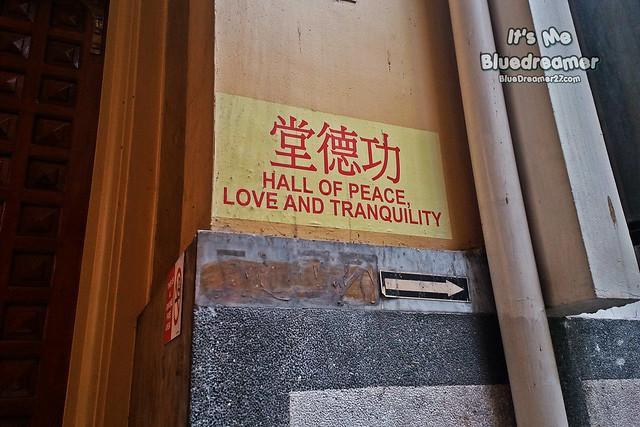 On the left side of the temple you will encounter a huge hall, the Hall of Peace, Love and Tranquility.
On the left side of the temple you will encounter a huge hall, the Hall of Peace, Love and Tranquility. 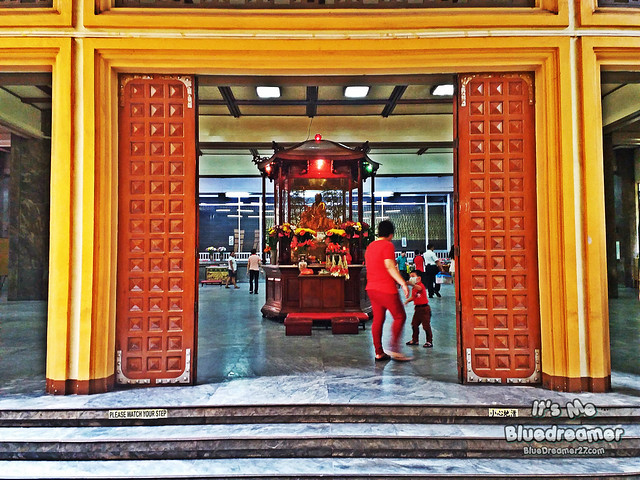
Hall of Peace, Love and Tranquility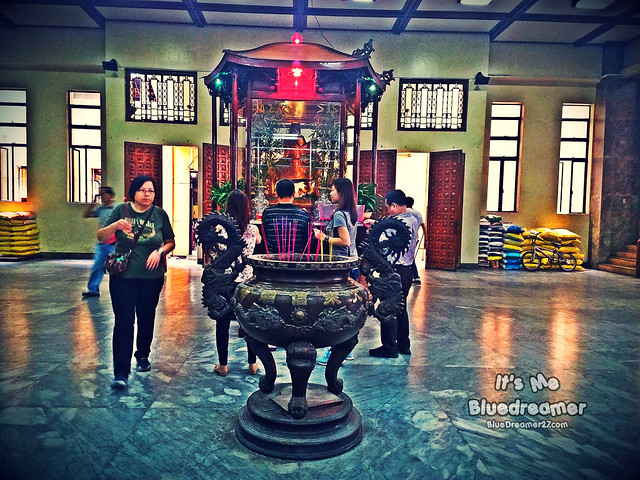
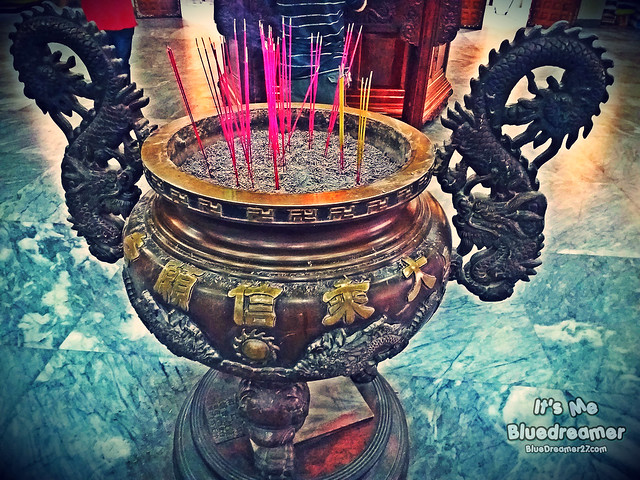 Another bowl of ashes which is very identical to what we have seen in Kuang Kong Temple in Kipuja St
Another bowl of ashes which is very identical to what we have seen in Kuang Kong Temple in Kipuja St
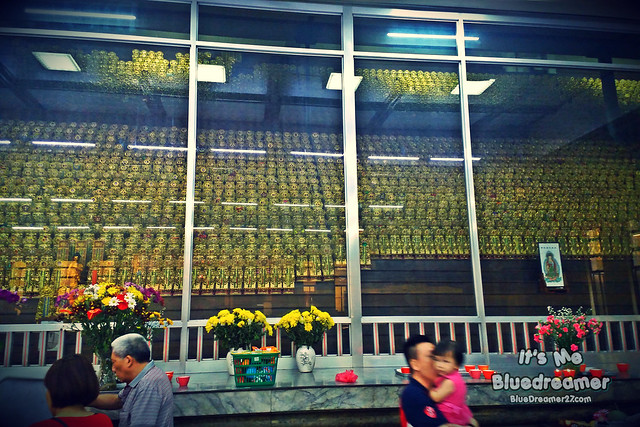 Interestingly, the hall contains huge repository for urns of human ashes. The ashes are placed inside golden container.
Interestingly, the hall contains huge repository for urns of human ashes. The ashes are placed inside golden container. 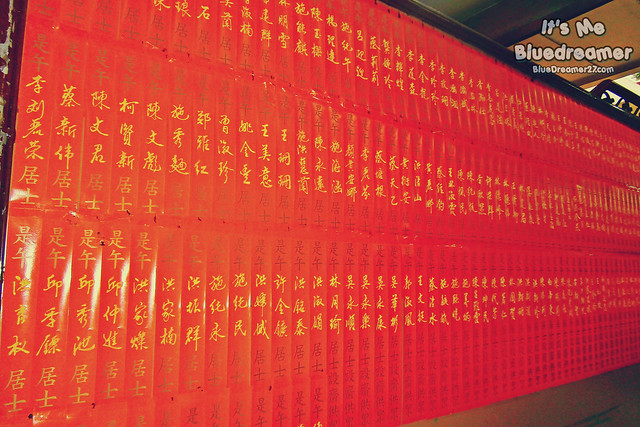 In this area, you’ll find names of devotees who has contributed to the temple past or living
In this area, you’ll find names of devotees who has contributed to the temple past or living
Next Entry : Lion and Dragon Dances in Binondo
Check Out The Rest of My Binondo Trip Here
Binondo Church │Plaza San Lorenzo Ruiz│Nuestra Señora Dela Soledad De Manila Parish │Cafe Mezzanine │Seng Guan Temple│Lion and Dragon Dances │Lucky China Town │Cosplayers In Binondo│Sto Cristo De Longos De Binondo│Dong Bei Dumplings │Shanghai Fried Siopao│Kuang Kong Temple│Sta Cruz Parish Church │Sincerity Restaurant │Ho-Land & Eng Bee Tin
•Special thanks to Kei Yang for clarifying all the details about the Seng Guan Temple
•Also I would like to note that visitors as much as possible should refrain themselves from taking pictures inside the temple. It was not my intention to disrespect the temple. This post is made for educational purposes only.



This temple look majestic and peaceful to me. Thanks for sharing these very beautiful picture of temple Seng Guan.
I would like to visit this temple along with the culinary trip in the busy streets of Binondo 🙂 The temple looks majestic and it is very interesting to see Chinese practices in that place.
I have been wanting to do a food trip around BInondo, now I shall add even this temple on the list.
Binondo really has a lot of secrets– culinary and cultural alike! 🙂 I’ve never visited Seng Guan during my past travels to Binondo but I’ll make sure to do so next time. 🙂
Inuubos mo na yung Binondo! Hehe. Love the series 🙂 Gets your audience in the loop of what is there to see in the place. Thanks!
Wonderful photos. I have been to Binondo several times but never got to visit any temple there. We always end up in eateries. This year, as I already spent CNY in Bacolod City, my hometown, I was able to visit a Buddhist temple and see how they observe their local tradition.
Would love to visit this place when I visit Binondo.
Another Binondo explorer!!! Haha
Would visit this place when I visit Binondo soon!!
Keep posting xx
I’ve read so many reviews about Binondo and I can’t wait to visit it.
I will visit binondo really really soon, this summer i will take 1 day for binondo alone, i will try Authintec Chinese food and explore the temple, thanks for sharing this post. 🙂
Been reading quite a lot about your exploration in this part of Manila. And I am amazed to learn how interesting this place is, like this preserved traditional temple, I should say.
Ive never been in binindo temple. Now j have more reason to go back im binondo aside from buying gold jewelries
Another great post for Binondo. With every post you share, my desires for visiting this historic place in Manila heightens.
I have never tried celebrating Chinese New Year and going to Binondo. I hope I can visit this next year.
I frequent Cafe Mezzanine to satisfy my cravings for Chinese food. Since Binondo is not far from our place, we regularly visit the place for fried siopao, hopia and authentic noodles.
Awesome photos man. I am loving the binondo series. Keep it up!
Manila has so many hidden gems! I consider sen guan temple as one since I have never been there but looking forward to soon!
Hi Dear,
Point of clarification, not all imagea in the Temple are called Buddha, they are called dieties or bodhisattva, similar to Catholic saints. They are there for specific reasons one is for protection, wealth etc. For the incense, yellow is used if a love one dies bellow 3 years and red ones if they have been gone for more than 3 years. That is if you are praying for their soul. If for personal reasons use red or you have to count all the dieties in the temple and leave 3 sticks at the main altar and one for each diety. Because when inside you have to pay respect to all who is there not just the main altar. Those are not red amulets they are names of devotees who has contributed to the temple past or living. ☺
I hope that you’re aware of how disrespectful you’ve been on your trip to Seng Guan. Taking pictures of the worshippers and the shrines is rude and crass. Please don’t do that again.